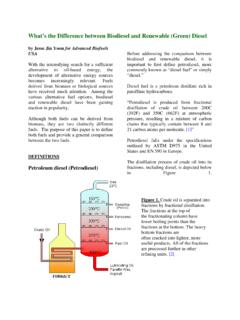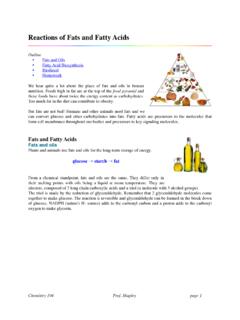Transcription of Diversified CPC International
1 Div24338. iedRoad CP C In te r na tio Channahon, IL 60410-9719. n al 1-888-AEROSOL. LIQUEFIED. GAS. PROPELLANT. HANDBOOK. Page | 1. Introduction An aerosol propellant is defined as an essentially non-toxic material capable of exerting pressure in a sealed container at ambient temperatures. The two basic classes of aerosol propellant include the compressed gas propellants (carbon dioxide, nitrous oxide, and nitrogen) and the liquefied gas propellants (hydrocarbons, fluorocarbons, and ethers). Compressed Gas Carbon Dioxide Propellants Inert Gases Nitrous Oxide Nitrogen Liquefied Petroleum Gases Hydrocarbons (Propane, Isobutane, n-Butane). Isopentane, n-Pentane Liquefied Gas 1,1 Difluoroethane (152a). Propellants Fluorocarbons 1,1,1,2 Tetrafluoroethane (134a). Ethers Dimethyl Ether Diversified CPC International supplies liquefied gas propellants to domestic and export markets. This brochure is intended to provide basic information regarding liquefied gas propellants.
2 Advantages that are realized by use of liquefied gas propellants include chemical stability, environmental acceptability and low toxicity. Liquefied gas propellants are high purity, non-corrosive, and the pressure obtained in an aerosol container will remain essentially constant over the duration of use of the product. Diversified CPC International welcomes inquiries from prospective users of our liquefied gas products. Page | 2. Important Please read Information contained in this brochure is considered to be reliable, however no guarantee or warranty is implied or intended. Nothing contained herein is to be construed as permission or recommendation to practice a patented invention without a license. Information is presented for your consideration and verification. Products listed herein should not be used for food, drug, cosmetic or commercial purposes until you have determined safety and legality of usage. Page | 3. Product Delivery Diversified CPC International maintains a substantial fleet of rail tank cars and truck transports for liquefied gas product distribution throughout the United States.
3 All tank cars and transports are dedicated assuring maximum product purity Various sizes of tank cars and transports are available to meet individual customer requirements. Tank car capacity is 30,500 gallons. Transports are available in capacities of 2,000 through 10,000 gallons. Tank car shipments can be made within 48 hours of order for all products. Transport deliveries within a 500-mile radius of our terminals normally require a lead lime of 24 to 36 hours. Page | 4. Physical Properties of Liquefied Gases Figure 1. A-17 A-31 A-108 Isopentane n-Pentane DME 152a 134a Formula C4H10 C4H10 C3H8 C5H12 C5H12 CH3-O-CH3 CH3-CHF2 CF3-CFH2. Molecular Weight Vapor Pressure @ 70 F (psig) Vapor Pressure @ 100 F (psig) Boiling Point @ 1 ATM., F 82 97 -13 Freezing Point @ 1 ATM., F -223 -179 Auto Ignition Temperature F 761 860 842 788 588 662 849 - Specific Gravity Liquid @ 60 F Specific Gravity Gas @ 60 F Density of Liquid @ 60 F Vol.
4 Of Vapor/lb. @ 60 F ( ) Vol. of Vapor/gal. @ 60 F ( ) Gas Vol. @ 1 ATM. & 60 F Critical Temperature F Critical Pressure (psia) 616 Flash Point F -101 -117 -156 -60 -40 -42 -58 Non Flammable Spec. Heat of Gas, Cp @ 60 F, BTU/lb F Spec. Heat of Liquid, Cp @ 60 F, BTU/lb F Heat of Vaporization, BTU/lb F@ BP Net Heat of Comb. of Liquid, 77 F BTU/lb 19,657 19,589 19,918 19,304 19,495 12,397 4,937 0. Chemical Heat of Comb. (kJ/g) 0. Viscosity of Liquid, centipoise @100 F Coefficient of Liquid Expansion @60 F Solubility in water @ 70 F (%by weight) Neg. Neg. Solubility of water @ 70 F (%by weight) Surface Tension @ 77 F (dynes/cm) Kauri-Butanol Value 20 18 15 N/A N/A 60 11 Flammability Limits in Air - - - - - - - Non Flammable Page | 5. Vapor Pressure of Liquefied Gases Figure 2. Propane 134a 152a Dimethyl Ether Pressure (psig). Isobutane n-Butane Isopentane n-Pentane Temperature F. Page | 6. Liquid Density of LP Gas Blends Figure 3.
5 N-Butane/Propane Blends n-Butane/Isobutane/Propane Blends (Based on Blends containing a mixture of 40% Isobutane and 60% n-Butane by weight and blended with Propane.). Density, Pounds / Gallon @ 60 F. Isobutane/Propane Blends 0 10 20 30 40 50 60 70 80 90 100. Volume Percent of Propane in Blend Page | 7. Solubility of Butane and Propane in Water Figure 4. Butane Propane Solubility, Percent by weight 50 60 70 80 90 100 110 120 130 140 150. Temperature F. Page | 8. Product Blends Liquefied Gas Products Hydrocarbon Liquefied Petroleum Gases H. H H HC H H H. H H H. H C C H H C C. H C H C C H. C. H H HC H C H H H. H H H. H H. PROPANE ISOBUTANE N-BUTANE. Pentanes H. H H H H H. H C H H. H H H C C C H. H C C C C. C C H H H H. H H H H. H H. ISOPENTANE N-PENTANE. Fluorocarbon Ether H F F F H H. H C C F F C C H H C O C H. H H F H H H. 1,1 1,1,1,2. DIFLUOROETHANE TETRAFLUOROETHANE DIMETHYL ETHER. (152a) (134a). Diversified CPC International has facilities to provide any blend of Propane, Isobutane, Normal Butane, Isopentane, Normal Pentane, 1,1-Difluoroethane (152a), 1,1,1,2- Tetrafluoroethane (134a), and Dimethyl Ether for desired composition or vapor pressure.
6 Page | 9. Naming Conventions Liquefied Petroleum Gas propellants produced and marketed by Diversified CPC. International are designated as: A for propane, isobutane, n-butane, or blends of propane and isobutane, or blends of isobutane and n-butane, NP for blends of propane and n-butane, and NIP for blends of propane, isobutane, and n-butane. The ratio of isobutane to n-butane is fixed at 2 to 3 ( ). and a number representing the vapor pressure at 70 F. The following table cross references the LP Gas propellant designations used by other manufacturers: LP Gas Propellant Code Cross Reference Diversified CPC Aeropres Corp Technical Propellants Phillips A A A A. NP AB BP BP. NIP Aeropin T BIP. Examples: A-17 is n-butane. A-24 is a blend of n-butane and Isobutane having a vapor pressure of 24. psig at 70 F. A-31 is Isobutane. A-70 is a blend of Isobutane and Propane having a vapor pressure of 70. psig at 70 F. A-108 is Propane. NP-46 is a blend of n-Butane and Propane having a vapor pressure of 46.
7 Psig at 70 F. NIP-52 is a blend of n-Butane, Isobutane, and Propane having a vapor pressure of 52 psig at 70 F such that the ratio of Isobutane and n-butane is fixed at 2/3. All other propellant blends produced and marketed by Diversified CPC International are designated by the blend components, followed by the components respective weight percentages in parenthesis. Page | 10. Examples: A31/152a (25/75) is a blend of 25% by weight isobutane and 75% by weight 1,1 Difluoroethane. A46/DME (45/55) is a blend containing 45% by weight of A-46 and 55% by weight Dimethyl Ether. Figure 1 provides information on selected physical properties of liquefied gas aerosol propellants. Figure 2 provides information on vapor pressures of liquefied gas aerosol propellants as a function of temperature. Figure 3 provides information on the liquid density of Hydrocarbon Propellant Blends. Solubility data of hydrocarbon propellants in water is given in Figure 4.
8 Figures 5 through 10 are detailed versions of vapor pressure vs. temperature charts for the more commonly used hydrocarbon propellant blends used by the aerosol industry. Page | 11. Vapor Pressure Calculation Vapor pressures resulting from mixtures of the hydrocarbon propellants can, for practical purposes be determined through the application of Raoult's Law, which states the partial pressure of each component is proportional to its molar concentration in the solution. For binary ideal solutions, it is possible to calculate the vapor pressure from the following equation, P = p1 + p2 = P1X1 + P2X2 , where P = Total Pressure p1 and p2 = partial pressure of each component P1 and P2 = vapor pressure of each pure component X1 and X2 = mole fraction in the liquid phase A mole is expressed in terms of standard weight systems, the g-mol or lb-mol, and the number of moles is found by dividing the weight percentage by the molecular weight.
9 The mole fraction is the number of moles of the component divided by the sum of moles of all components. Example 1. Propellant Propane - 16% by wt. Isobutane - 84% by wt. Moles of propane in the mixture = 16 = Moles of isobutane in the mixture = 84 = Total number of moles = Mole fraction of propane = Vapor pressure of propane @ 70 F = 124 psia. Mole fraction of isobutane = Vapor pressure of isobutane @ 70 F = psia. Total Pressure (124 x .2007) + ( x .7993) = psia. = psig. Page | 12. Conversely, if the vapor pressure of a blend of propane and isobutane is specified as 46. psig at 70 F then let X be the mole fraction of propane in the blend. Mole fraction of lsobutane in the blend = 1 -X. Absolute vapor pressure of blend = + = psia Then from Raoult's Law, (1 -X) (Vapor pressure of isobutane @ 70 F) + X(vapor pressure of propane @ 70 F). = vapor pressure of blend @ 70 F. Substituting the vapor pressures, (1 -X) + 124X = Therefore, - + 124X = Transposing, X(124 - ) = - Hence X = = = mole fraction of propane and 1 - X = 1 - = = mole fraction of isobutane 1 mole of mixture contains mole of propane = * = lbs.
10 And mole of isobutane * = Ibs. Wt. % Propane in mixture = Raoult's law cannot be used for accurate vapor pressure calculations involving blends of dimethyl ether or the fluorocarbon propellants. Page | 13. A-Blends Figure 5. Vapor Weight% Mole% Liquid Volume % (60 F) Liq. Den. Pressure n-Butane Isobutane Propane n-Butane Isobutane Propane n-Butane Isobutane Propane 60 F lb/gl 17 20 24 28 31 32 33 34 35 36 37 38 39 40 41 42 43 44 45 46 47 48 49 50 51 52 53 54 55 56 57 58 59 60 61 62 63 64 65 66 67 68 69 70 71 72 73 74 75 Page | 14. Vapor Weight% Mole% Liquid Volume % (60 F) Liq. Den. Pressure n-Butane Isobutane Propane n-Butane Isobutane Propane n-Butane Isobutane Propane 60 F lb/gl 76 77 78 79 80 81 82 83 84 85 86 87 88 89 90 91 92 93 94 95 96 97 98 99 100 101 102 103 104 105 106 107 108 Page | 15. NP-Blends Figure 6. Vapor Weight% Mole% Liquid Volume % (60 F) Liq. Den. Pressure n-Butane Isobutane Propane n-Butane Isobutane Propane n-Butane Isobutane Propane 60 F lb/gl 31 32 33 34 35 36 37 38 39 40 41 42 43 44 45 46 47 48 49 50 51 52 53 54 55 56 57 58 59 60 61 62 63 64 65 66 67 68 69 70 71 72 73 74 75 76 77 78 79 Page | 16.

